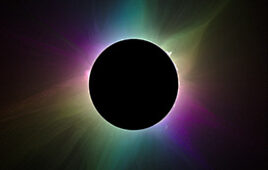Astronomers predict that large spiral galaxies, like our Milky Way, have
hundreds of satellite galaxies orbiting around them. While a few satellites are
visible, like the Magellanic Clouds, many other galaxies are too dim to see.
Scientists suspect that these faint satellite galaxies are primarily comprised
of mysterious dark matter, which makes up 85% of all matter in the universe and
so far remains undetected.
Using supercomputers at the National Energy Research Scientific Computing
Center (NERSC), Sukanya Chakrabarti, has developed a mathematical method
uncover these “dark” satellites. When she applied this method to our own Milky
Way galaxy, Chakrabarti discovered a faint satellite might be lurking on the
opposite side of the galaxy from Earth, approximately 300,000 light-years from
the galactic center.
“Our approach has broad implications for many fields of physics and
astronomy—for the indirect detection of dark matter as well as dark-matter
dominated dwarf galaxies, planetary dynamics, and for galaxy evolution
dominated by satellite impacts,” says Chakrabarti, who presented these findings
at the American Astronomical Society meeting in Seattle. This result came from Chakrabarti’s
postdoctoral research at the Univ. of California, Berkeley.
She is currently an assistant professor of physics at Florida Atlantic Univ.
Using math to find invisible mass
Chakrabarti’s technique involves an analysis of the cold atomic hydrogen
gas that comprise the outskirts of a large spiral galaxy’s disk. This cold gas
is gravitationally confined to the galactic disk and extends much further out
than the visible stars—sometimes up to five times the diameter of the visible
spiral. This gas can be mapped by radio telescopes.
According to Chakrabarti, the dark satellite galaxies create disturbances in
the cold atomic hydrogen gas at the edges of the spiral galaxy’s disk, and
these perturbations reveal the mass, distance, and location of the satellite.
With the help of NERSC systems, she successfully validated her method by
analyzing the radio observations of the Whirlpool Galaxy, which has a visible
satellite one-third of its size, and NGC 1512, which has a satellite
one-hundredth its size. Her calculations correctly predicted the mass and
location of both of the known satellite galaxies.
When she applied this analysis to radio observations of our own Milky Way,
the analysis revealed a potential dwarf galaxy, or Galaxy X, sitting in the
constellation of Norma or Circinus, just west of the galactic center in
Sagittarius when viewed from Earth. Because this satellite sits across the
Milky Way from Earth, it is obscured in our line of sight by gas and dust, and
thus has not been detected.
According to her colleague Leo Blitz of the Univ.
of California at Berkeley, searching for satellite galaxies
with this method is like inferring the size and speed of a ship by looking at
its wake. “You see the waves from a lot of boats, but you have to be able to
separate out the wake of a medium or small ship from that of an ocean liner,”
he says.
“The NERSC systems really sped up my work,” says Chakrabarti. “These systems
are a great resource. I am currently using my method to develop a test of
modified theories of gravity, and plan on running the simulations at NERSC.”
Galactic tango in 3D
To illustrate how a satellite galaxy disrupts the gas disk of a large
spiral for the American Astronomical Society (AAS) Conference in January 2011,
Chakrabarti turned to NERSC Analytics team member Prabhat who translated her
scientific data into a three-dimensional (3D) movie for the Space Science Telescope
Institute Booth with the VisIt software.
“When a person looks up at the night sky from Earth, they can’t tell the
difference between a star that is far away and one that is nearby. It is the
same when you are running simulations on a flat screen, you see bands that
stretch in and out but you don’t get the depth that a 3D visualization
provides,” says Prabhat.
“Visualizing the merger of two galaxies is like watching a stone drop into a
pond. A 2D slice lets you see the ripples, but a 3D view will let you see the
splash. In this case of galaxy mergers, a 3D visualization lets us see the
splash of the gas and instabilities in the galactic disk in real-time,” says
Chakrabarti. “This depth is invaluable when you are studying dynamical
phenomenon with variation in the plane.”
Chakrabarti’s allocation at NERSC was provided by the Office of High Energy
Physics’ (HEP) Baryon Oscillation Spectroscopic Survey (BOSS) project, which is
mapping the Universal expansion rate in unprecedented precision. HEP is a part
of the Department of Energy’s office of Science. The radio observations of our
Milky Way’s gas disk came from the HI Nearby Galaxy Survey (THINGS) conducted
by the Very Large Array, and its extension in the Southern Hemisphere,
THINGS-SOUTH, a survey carried out by the Australia Telescope Compact Array.




